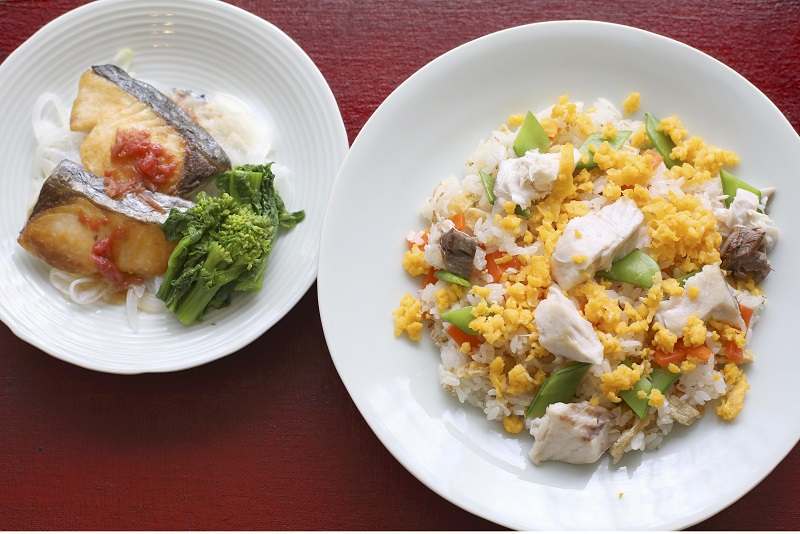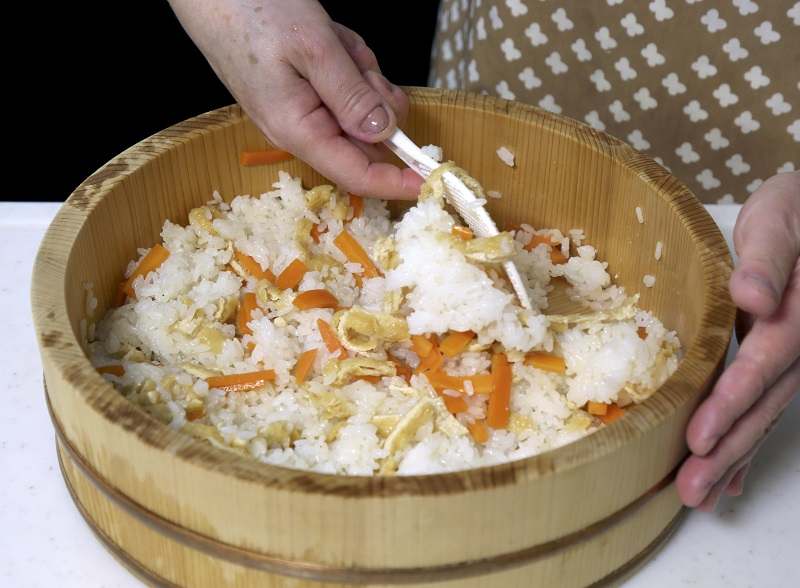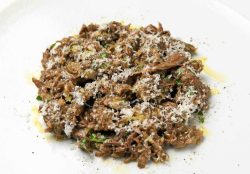
Sauteed sawara with umeboshi sauce, left, and chirashi-zushi with sawara
15:59 JST, May 11, 2021
Japanese Spanish mackerel is in season. The fish is called sawara in Japanese, and the kanji signifying it combines the characters for “spring” and “fish.” That’s quite befitting. Sawara is a popular fish along the Seto Inland Sea in western Japan, where it is referred to as the “fish marking the arrival of spring.”
Cooking expert Seiko Taguchi shared two recipes for making excellent use of sawara, known for its fattiness and mild taste.
“Sawara is easy for anyone to eat, from children to the elderly, as it doesn’t have an overly distinctive flavor and the fillets have few bones,” Taguchi said.
Taguchi’s first recipe is for chirashi-zushi, sushi rice served with a variety of ingredients on top. Here, the cherry on top is grilled sawara.
“This dish looks gorgeous and is perfect for spring or on celebratory occasions,” Taguchi said.
As the sawara is not mixed with the sushi rice, the delicious flavor of its fatty white meat can be enjoyed on its own. Also, the scrambled eggs make the dish look like a field filled with beautiful rape flowers.
Chirashi-zushi with sawara
Ingredients (serves 3-4):
- 360ml rice
- 3 sawara fillets
- 2 eggs
- 80 grams carrots
- 2 sheets abura-age (thin, deep-fried tofu)
- 30 grams snow peas
- 2 tbsp white sesame seeds
- 300ml dashi broth
- ¼ tsp salt
- 1 tbsp soy sauce
- 1 tbsp sugar
- 2 tbsp mirin

Sushi rice is mixed with carrots and abura-age.
Directions:
1. Sprinkle sawara fillets with salt and leave them for about 10 minutes. Grill them on a fish grill, then remove the skin and bones.
2. Mix 66 milliliters of vinegar, 1 teaspoon of salt and 1½ tablespoons of sugar to make sushi vinegar.
3. Sprinkle the sawara with 1 tablespoon of the sushi vinegar to add a little sweetness, and break it up into pieces in the preferred size.
4. Crack eggs into a bowl, add a pinch of salt and 1 tablespoon of sugar, and mix. Pour the mixture over a frying pan and heat it while scrambling with four kitchen chopsticks. When the eggs start to become hard, remove the pan from the heat, place it on a kitchen towel, and further scramble, to make the eggs a vivid yellow, without browning them too much.
5. Cut carrot and abura-age, whose surface oil has been removed with hot water, into 2-centimeter-wide strips each, and place in a pan.
6. Add dashi broth, salt, soy sauce, sugar and mirin, and simmer over medium heat until the liquid evaporates.
7. Remove stringy parts from snow peas, put in boiling water with a pinch of salt, and then cut diagonally into 1-centimeter-wide pieces.
8. Put rice, cooked a little harder than usual, into a bowl, add the remaining sushi vinegar, mix with a spatula or similar utensil as if cutting, and let sit for about 10 minutes. When mixing, add the sushi vinegar little by little while rotating the bowl so that all the rice is evenly seasoned with the vinegar. Add carrot and abura-age, and mix. Add white sesame seeds and mix.
9. Place sushi rice on a plate. Top with sawara, scrambled egg and snow peas.
The second dish is sauteed sawara with pickled plum sauce.
This salad-like dish has a light taste that enhances the mild flavor of the seasonal sawara and onion.
Sauteed sawara with plum sauce
Ingredients (serves 2):
- 2 sawara fillets
- 150 grams seasonal onion
- 3 rape flower stalks
- Wheat flour
- 1 piece pickled plum
- 2 tsp mirin
- 1 tsp soy sauce
- ½ tbsp vinegar
- ½ tbsp water
Directions:
1. Cut sawara fillets in half, sprinkle with a pinch of salt, and dust with wheat flour.
2. Heat 1 tablespoon of cooking oil in a frying pan and saute both sides of the sawara fillets over medium heat uncovered, until the surfaces become crispy. Touch the fish only when turning over so as not to break it.
3. Thinly slice seasonal onion. Cut rape flower stalks in half. Put the onion into boiling water for just a few seconds and scoop from the water. Boil the rape flower stalks until they become soft and remove.
4. Mix mirin, soy sauce, vinegar and water, and heat in a microwave at 600 watts for 30 seconds. Remove the stone from the umeboshi, chop the flesh and mix with the liquid mixture.
5. Drain seasonal onion and place on a plate, top with sawara and rape flower stalks, and pour the plum sauce on top.
“Cooking with a seasonal fish makes for a delightful dining experience,” Taguchi said. These two dishes have the refreshing smell of spring.
"Features" POPULAR ARTICLE
-

Sanrio to Open Museum in Yamanashi Pref. Dedicated to Founder, Exhibits Include Hello Kitty, Other Characters
-

Legendary Sushi Chef Jiro Ono Turns 100: ‘I Have No Regrets’
-

Autumn Foliage Surrounds Visitors to Tokyo’s Showa Kinen Park
-

My Daughter No Longer Speaks to Me, But I Want to See Her and My Grandchild
-

Kumamoto: Public Bath Refurbished as Library Where You Can Chat, Take Photos
JN ACCESS RANKING
-

Keidanren Chairman Yoshinobu Tsutsui Visits Kashiwazaki-Kariwa Nuclear Power Plant; Inspects New Emergency Safety System
-

Imports of Rare Earths from China Facing Delays, May Be Caused by Deterioration of Japan-China Relations
-

University of Tokyo Professor Discusses Japanese Economic Security in Interview Ahead of Forum
-

Japan Pulls out of Vietnam Nuclear Project, Complicating Hanoi’s Power Plans
-

Govt Aims to Expand NISA Program Lineup, Abolish Age Restriction


























